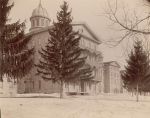Difference between revisions of "Portal:Featured Article Of The Week"
M-Explorer (talk | contribs) |
M-Explorer (talk | contribs) |
||
| (351 intermediate revisions by the same user not shown) | |||
| Line 1: | Line 1: | ||
{{FAformat | {{FAformat | ||
| − | |Title= | + | |Title= Mendota Mental Health Institute |
| − | |Image= | + | |Image= Mendota03.jpg |
|Width= 150px | |Width= 150px | ||
| − | |Body= | + | |Body= Mendota opened on July 14, 1860 when it admitted a patient who had been brought all the way from Oconto County...a long trip by horse and wagon. Even though the hospital was not yet ready to open, that Saturday it was decided that, because of the distance the patient had been brought, he should be received. Thus began Mendota's ready response to the needs of patients and communities, which has been its tradition. |
| − | + | Mendota has gone through many changes since then, some of them dramatized in the changes in its name. It opened as an "Asylum", appropriate in an era when little could be done for the mentally ill except to house and care for them...i.e. to give them asylum...when their families and communities could no longer cope with their needs. | |
| − | + | In a later era, when patients were recognized as having an illness...mental illness...the name was changed to Mendota State Hospital, reflecting its responsibility for providing treatment. | |
| − | + | In more recent times, with the discovery of psychiatric medications and with new approaches (some of which resulted from research at Mendota itself) it became possible for the mentally ill to be treated in community hospitals and clinics. But there remained a need for a place for those who required more specialized treatment than most community hospitals and clinics could provide, and where the tradition of research, education, and consultation that Mendota had already established could continue. Mendota was then changed to its present name of Mendota Mental Health Institute. [[Mendota Mental Health Institute|Click here for more...]] | |
}} | }} | ||
Revision as of 04:45, 2 August 2020
Featured Article Of The Week
Mendota Mental Health Institute
Mendota opened on July 14, 1860 when it admitted a patient who had been brought all the way from Oconto County...a long trip by horse and wagon. Even though the hospital was not yet ready to open, that Saturday it was decided that, because of the distance the patient had been brought, he should be received. Thus began Mendota's ready response to the needs of patients and communities, which has been its tradition.
Mendota has gone through many changes since then, some of them dramatized in the changes in its name. It opened as an "Asylum", appropriate in an era when little could be done for the mentally ill except to house and care for them...i.e. to give them asylum...when their families and communities could no longer cope with their needs.
In a later era, when patients were recognized as having an illness...mental illness...the name was changed to Mendota State Hospital, reflecting its responsibility for providing treatment.
In more recent times, with the discovery of psychiatric medications and with new approaches (some of which resulted from research at Mendota itself) it became possible for the mentally ill to be treated in community hospitals and clinics. But there remained a need for a place for those who required more specialized treatment than most community hospitals and clinics could provide, and where the tradition of research, education, and consultation that Mendota had already established could continue. Mendota was then changed to its present name of Mendota Mental Health Institute. Click here for more...
